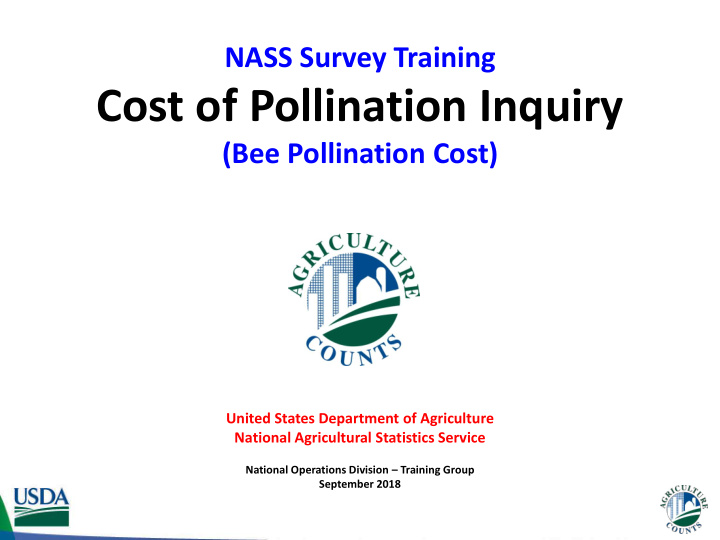



NASS Survey Training Cost of Pollination Inquiry (Bee Pollination Cost) United States Department of Agriculture National Agricultural Statistics Service National Operations Division – Training Group September 2018
Survey Overview • The purpose of the Cost of Pollination Survey is to ask crop producers about the fees they paid for honey bee pollination and any other expenses related to pollinating their crops. • Public value in providing commodity specific pollination costs as these expenditures are a necessary part of the industry that is directly tied to the health of the honeybee industry. • Helps crop producers, beekeepers, researchers, and policy makers in the decision making process.
Survey Information • Project Code: 118 – Bee Pollination Cost • Questionnaires: – Mailed out around October 10 th – EDR also available • Release: – Cost of Pollination – December 21, 2018 at 12 pm (EST)
Section 1 – Honey Bee Pollination • During 2018, did this operation listed on the label own or have any honey bee colonies brought in for pollination? – Yes = Continue – No = Go to Section 3 (other pollination costs) • During 2018, how many total honey bee colonies did this operation use to pollinate crops? – Include all colonies owned or brought onto this operation – Report in # of colonies • During 2018, what was the total amount paid by this operation to beekeepers to pollinate all crops? – Report in total dollars
Section 2 – Cost of Honey Bee Pollination • Crop categories for survey questions: – Almonds -Peaches/Nectarines – Alfalfa for seed -Pears – Apples -Pumpkin – Blueberries -Raspberries – Cantaloupe -Squash – Cherries -Strawberries – Clover for seed -Sunflowers – Cranberries -Watermelon – Cucumber -All other crops (specify) – Oranges
Section 2 – Cost of Honey Bee Pollination Questions: • How many acres of the crop did honey bees pollinate? – Report down to the nearest tenth of an acre • How many colonies of honey bees did this operation own or bring in to pollinate the crop? – Broken down between owned/non-owned colonies – Report # of colonies • Did this operation pay for honey bees to pollinate any of the crop? – Yes = Continue – No = Go to the next crop • For how many acres of the crop did this operation pay for pollination by honey bees? – Report to the nearest tenth of an acre • What was the total amount this operation paid for honey bees not owned by this operation to pollinate the crop? – Report to the nearest whole $
Section 3 – Other Pollination Costs • During 2018, did this operation pay for products or services used to increase pollination that did not involve honey bees? – Exclude any fees, expenses, or costs related to honey bees • If yes: – A) How much did this operation pay in 2018 for pollination using other, non-apis, bees • Bumble, cutter, etc. – B) How much did this operation pay in 2018 for artificial pollination? – C) How much did this operation pay in 2018 for all other forms of increasing pollination? • Flower mixes, bee attractants, bat houses, etc.
Things to Watch Out For • Be aware of decimal points on acreage • If they answer “Yes” to paying for pollination be sure to collect expenditures • Out Of Business – Verify they are really out of business • And just didn’t screen out of this survey – Collect new operator’s information • Section 5 – Change in Operator • Leave good notes
Reluctant Response • Why should I report? What’s in it for me? – I understand your concern and others have felt the same way. However, there are limited sources on the cost of pollination and the fees paid for pollination. It is important that we collect this information because it helps to estimate the cost for crop producers. It also provides key information about the pollination aspect of the honey bee industry.
Conclusion • When in doubt, comment it out • Practice on your iPad • Contact your supervisor or local office with any specific questions • Have a good survey!
Recommend
More recommend